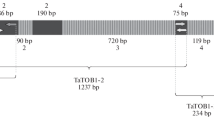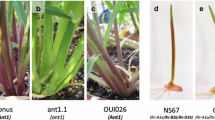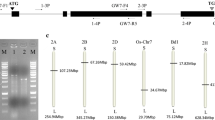Abstract
The majority of genes present in the hexaploid bread wheat genome are present as three homoeologs. Here, we describe the three homoeologous orthologs of the barley cleistogamy gene Cly1, a member of the AP2 gene family. As in barley, the wheat genes (designated TaAP2-A, -B and -D) map to the sub-telomeric region of the long arms of the group 2 chromosomes. The structure and pattern of transcription of the TaAP2 homoeologs were similar to those of Cly1. Transcript abundance was high in the florets, and particularly in the lodicule. The TaAP2 message was cleaved at its miR172 target sites. The set of homoeolog-specific PCR assays developed will be informative for identifying either naturally occurring or induced cleistogamous alleles at each of the three wheat homoeologs. By combining such alleles via conventional crossing, it should be possible to generate a cleistogamous form of bread wheat, which would be advantageous both with respect to improving the level of the crop’s resistance against the causative pathogen of fusarium head blight, and for controlling pollen-mediated gene flow to and from genetically modified cultivars.







Similar content being viewed by others
References
Aukerman MJ, Sakai H (2003) Regulation of flowering time and floral organ identity by a microRNA and its APETALA2-like target genes. Plant Cell 15:2730–2741
Ban T, Suenaga K (2000) Genetic analysis of resistance to fusarium head blight caused by Fusarium graminearum in Chinese wheat cultivar Sumai 3 and the Japanese cultivar Saikai 165. Euphytica 113:87–99
Bartel DP (2009) MicroRNAs: Target recognition and regulatory functions. Cell 136:215–233
Bottley A, Xia GM, Koebner RMD (2006) Homoeologous gene silencing in hexaploid wheat. Plant J 47:897–906
Brown RH, Bregitzer P (2011) A Ds insertional mutant of a barley mir172 gene results in indeterminate spikelet development. Crop Sci 51:1664–1672
Chapman V, Miller TE, Riley R (1976) Equivalence of the a genome of bread wheat and that of Triticum urartu. Genet Res 27:69–76
Chen X (2004) A microRNA as a translational repressor of APETALA2 in Arabidopsis flower development. Science 303:2022–2025
Chhabra AK, Sethi SK (1991) Inheritance of cleistogamic flowering in durum wheat (Triticum durum). Euphytica 55:147–150
Chuck G, Meeley R, Irish E, Sakai H, Hake S (2007) The maize tasselseed4 microRNA controls sex determination and meristem cell fate by targeting Tasselseed6/indeterminate spikelet1. Nat Genet 39:1517–1521
Coen ES, Meyerowitz EM (1991) The war of the whorls: genetic interactions controlling flower development. Nature 353:31–37
Comai L, Tyagi AP, Winter K, Holmes-Davis R, Reynolds SH, Stevens Y, Byers B (2000) Phenotypic instability and rapid gene silencing in newly formed Arabidopsis allotetraploids. Plant Cell 12:1551–1567
De Vries AP (1971) Flowering biology of wheat, particularly in view of hybrid seed production—a review. Euphytica 20:152–170
Endo TR, Gill BS (1996) The deletion stocks of common wheat. J Hered 87:295–307
Fu YB, Somers DJ (2009) Genome-wide reduction of genetic diversity in wheat breeding. Crop Sci 49:161–168
Gilsinger J, Kong L, Shen X, Ohm H (2005) DNA markers associated with low fusarium head blight incidence and narrow flower opening in wheat. Theor Appl Genet 110:1218–1225
Glover B (2007) Understanding flowers and flowering. New York, Oxford, p 227
Henikoff S, Till BJ, Comai L (2004) TILLING. Traditional mutagenesis meets functional genomics. Plant Physiol 135:630–636
Heslop-Harrison Y, Heslop-Harrison JS (1996) Lodicule function and filament extension in the grasses: potassium ion movement and tissue specialization. Ann Bot 77:573–582
Hori K, Kobayashi T, Sato K, Takeda T (2005) QTL analysis of fusarium head blight resistance using a high-density linkage map in barley. Theor Appl Genet 111:1661–1672
Ishikawa G, Nakamura T, Ashida T, Saito M, Nasuda S, Endo TR, Wu J, Matsumoto T (2009) Localization of anchor loci representing five hundred annotated rice genes to wheat chromosomes using PLUG markers. Theor Appl Genet 118:499–514
Jofuku KD, den Boer BG, Montagu MV, Okamuro JK (1994) Control of Arabidopsis flower and seed development by the homeotic gene APETALA2. Plant Cell 6:1211–1225
Kasschau KD, Xie Z, Allen E, Llave C, Chapman EJ, Krizan KA, Carrington JC (2003) P1/HC-Pro, a viral suppressor of RNA silencing, interferes with Arabidopsis development and miRNA function. Dev Cell 4:205–217
Kihara H (1944) Discovery of the DD-analyser, one of the ancestors of Triticum vulgare. Agric Hortic 19:889–890
Kilian B, Özkan H, Deusch O, Effgen S, Brandolini A, Kohl J, Martin W, Salamini F (2007) Independent wheat B and G genome origins in outcrossing Aegilops progenitor haplotypes. Mol Biol Evol 24:217–227
Kirby EJM, Appleyard M (1981) Cereal development guide. National Agricultural center Cereal Unit, Stoneleigh, Warwickshire, UK
Komatsuda T, Nakamura I, Takaiwa F, Oka S (1998) Development of STS markers closely linked to the vrs1 locus in barley, Hordeum vulgare. Genome 41:680–685
Kubo K, Kawada N, Fujita M, Hatta K, Oda S, Nakajima T (2010) Effect of cleistogamy on fusarium head blight resistance in wheat. Breeding Sci 60:405–411
Ma R, Zheng DS, Fan L (1996) The crossability percentages of 96 bread wheat landraces and cultivars from Japan with rye. Euphytica 92:301–330
Matus- Cádiz MA, Hucl P, Dupuis B (2007) Pollen-mediated gene flow in wheat at the commercial scale. Crop Sci 47:573–579
McMullen M, Jones R, Gallenberg D (1997) Scab of wheat and barley: a re-emerging disease of devastating impact. Plant Dis 81:1340–1348
Miller JC, Tan S, Qiao G, Barlow KA, Wang J, Xia DF, Meng X, Paschon DE, Leung E, Hinkley SJ, Dulay GP, Hua KL, Ankoudinova I, Cost GJ, Urnov FD, Zhang HS, Holmes MC, Zhang L, Gregory PD, Rebar EJ (2011) A TALE nuclease architecture for efficient genome editing. Nat Biotechnol 29:143–148
Nair SK, Wang N, Turuspekov Y, Pourkheirandish M, Sinsuwongwat S, Chen G, Sameri M, Tagiri A, Honda I, Watanabe Y, Kanamori H, Wicker T, Stein N, Nagamura Y, Matsumoto T, Komatsuda T (2010) Cleistogamous flowering in barley arises from the suppression of microRNA-guided HvAP2 mRNA cleavage. Proc Natl Acad Sci USA 107:490–495
Nevo E (2009) Ecological genomics of natural plant populations: the Israeli perspective. In: Somers DJ, Langridge P, Gustafson JP (eds) Methods in molecular biology, plant genomics, vol 513. Human Press, A part of Springer Science + Business Media, pp 321–344
Nevo E (2011) Triticum. In: Kole C (ed) Wild crop relatives: genomic and breeding resources, cereals. Springer, Berlin, pp 407–456
Parry DW, Jenkinson P, McLeod L (1995) Fusarium ear blight (scab) in small grain cereals. Plant Pathol 44:207–238
Petersen G, Seberg O, Yde M, Berthelsen K (2006) Phylogenetic relationships of Triticum and Aegilops and evidence for the origin of the A, B, and D genomes of common wheat (Triticum aestivum). Mol Phylogenet Evol 39:70–82
Riley R, Unrau J, Chapman V (1958) Evidence on the origin of the B genome of wheat. J Hered 49:91–98
Sato K, Hori K, Takeda K (2008) Detection of fusarium head blight resistance QTLs using five populations of top-cross progeny derived from two-row × two-row crosses in barley. Mol Breeding 22:517–526
Sears ER (1954) The aneuploids of common wheat. Univ Mo Agric Exp Stn Bull 572:1–58
Sears ER (1966) Nullisomic-tetrasomic combinations in hexaploid wheat. In: Rilly R, Lewis KR (eds) Chromosome manipulations and plant genetics. Oliver and Boyd, Edinburgh, pp 29–45
Sears ER, Sears MS (1978) The telocentric chromosomes of commonwheat. In: Ramanujam S (ed) Proceedings of the 5th international wheat genetics symposium. Indian Society of Genetics and Plant Breeding, New Delhi, pp 389–407
Sethi K, Chhabra AK (1990) Cleistogamy in wheat. Rachis 9:34–36
Shitsukawa N, Tahira C, Kassai KI, Hirabayashi C, Shimizu T, Takumi S, Mochida K, Kawaura K, Ogihara Y, Murai Y (2007) Genetic and epigenetic alteration among three homoeologous genes of a class E MADS box gene in hexaploid wheat. Plant Cell 19:1723–1737
Simons KJ, Fellers JP, Trick HN, Zhang ZC, Tai YS, Gill BS (2006) Molecular characterization of the major wheat domestication gene Q. Genetics 172:547–555
Snijders CHA (1990) Fusarium head blight and mycotoxin contamination of wheat, a review. Eur J Plant Pathol 96:187–198
Tamura K, Peterson D, Peterson N, Stecher G, Nei M, Kumar S (2011) MEGA5: molecular evolutionary genetics analysis using maximum likelihood, evolutionary distance, and maximum parsimony methods. Mol Biol Evol 28:2731–2739
Tang M, Li G, Chen M (2007) The phylogeny and expression pattern of APETALA2-like genes in rice. J Genet Genomics 34:930–938
Theissen G, Saedler H (2001) Floral quartets. Nature 409:469–471
Turuspekov Y, Mano Y, Honda I, Kawada N, Watanabe Y, Komatsuda T (2004) Identification and mapping of cleistogamy genes in barley. Theor Appl Genet 109:480–487
Urnov FD, Rebar EJ, Holmes MC, Zhang HS, Gregory PD (2010) Genome editing with engineered zinc finger nucleases. Nat Rev Genet 11:636–646
Wood AJ, Lo TW, Zeitler B, Pickle CS, Ralston EJ, Lee AH, Amora R, Miller JC, Leung E, Meng X, Zhang L, Rebar EJ, Gregory PD, Urnov FD, Meyer BJ (2011) Targeted genome editing across species using ZFNs and TALENs. Science 333:307
Wu J, Maehara T, Shimokawa T, Yamamoto S, Harada C, Takazaki Y, Ono N, Mukai Y, Koike K, Yazaki J, Fujii F, Shomura A, Ando T, Kono I, Waki K, Yamamoto K, Yano M, Matsumoto T, Sasaki T (2002) A comprehensive rice transcript map containing 6591 expressed sequence tag sites. Plant Cell 14:525–535
Zhang Z, Belcram H, Gornicki P, Charles M, Just J, Huneau C, Magdelenat G, Couloux A, Samain S, Gill BS, Rasmussen JB, Barbe V, Faris JD, Chalhoub B (2011) Duplication and partitioning in evolution and function of homoeologous Q loci governing domestication characters in polyploid wheat. Proc Natl Acad Sci USA 108:18737–18742
Zhou Y, Lu D, Li C, Luo J, Zhu BF, Zhu J, Shangguan Y, Wang Z, Sang T, Zhou B, Han B (2012) Genetic Control of Seed Shattering in Rice by the APETALA2 Transcription Factor SHATTERING ABORTION1. Plant Cell 24:1034–1048
Acknowledgments
We thank Y. Nagamura, J. Song, G. Chen, C. Liu and C. Li, H. Sassa, S. Kikuchi for their help and advice and K. Kakeda for comments on the manuscript. This research was funded by the Japanese Ministry of Agriculture, Forestry and Fisheries (Genomics for Agricultural Innovation grant no. TRG1004) to T.K. S.N. appreciates the award of a Japanese Government (Monbukagakusho: MEXT) scholarship.
Author information
Authors and Affiliations
Corresponding author
Additional information
Communicated by I. Godwin.
Electronic supplementary material
Below is the link to the electronic supplementary material.
Rights and permissions
About this article
Cite this article
Ning, S., Wang, N., Sakuma, S. et al. Structure, transcription and post-transcriptional regulation of the bread wheat orthologs of the barley cleistogamy gene Cly1 . Theor Appl Genet 126, 1273–1283 (2013). https://doi.org/10.1007/s00122-013-2052-6
Received:
Accepted:
Published:
Issue Date:
DOI: https://doi.org/10.1007/s00122-013-2052-6




